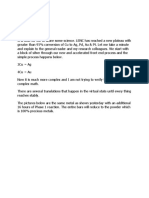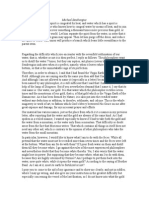Phonon - Data Math - Explanation.htm
Phonon - Data Math - Explanation.htm
Uploaded by
lightingfastno808Copyright:
Available Formats
Phonon - Data Math - Explanation.htm
Phonon - Data Math - Explanation.htm
Uploaded by
lightingfastno808Original Title
Copyright
Available Formats
Share this document
Did you find this document useful?
Is this content inappropriate?
Copyright:
Available Formats
Phonon - Data Math - Explanation.htm
Phonon - Data Math - Explanation.htm
Uploaded by
lightingfastno808Copyright:
Available Formats
http://www.drjoechampion.com/phonon.data/math.explanation.
htm
Understanding the mathematics of phonon resonance Prior to understanding the mathematics of phonon resonance, it is necessary to understand the theory behind phonon resonance. Phonon Resonance is the calculation of the physical resonance of an element or a molecule. If you can not put your mind around this, consider it as the frequency of a tuning fork. Each tuning fork has a different size due to their length. In retrospect, each atom resonates due to its physical size. To determine the size of an element, we need to take first assume that atoms are nearly symmetrical in diameter. To accomplish this requires several known constants. With permission, I will use the following formula. I would recommend that you have CRC Reference book Chemistry and Physics. Data is available on the internet.
The base formula consists of three variables. Na is a set and established constant named - Avogadro's Constant an established number is 6.022 141 5 1023 per mole. We take this number and multiply it times the density of an element. The density is the number of grams per cubic centimeter of an atom and can be found in many references. We them divide this by the atomic mass of the element and we would have the number of atoms in a cubic centimeter. By taking the cube of the centimeter, we know how physical diameter of the atom. Or, we now know its physical resonance.
In the chart found on this website General Table for Phonon resonance of Elements you will see the above formula applied to all the stable elements found on the Periodic Table with their stable isotopes. This is the easy part. It shows you which elements are similar to the element and /or isotope of the element you desire. From this point it becomes more difficult. Please allow me to explain. Metallic elements expand at a known state. This is the expansion coefficient. The expansion coefficient is the distance that an element will expand or contractor for a temperature rise or fall per degree Celsius. To explain how this works in reference to the charts, lets look at the inverse of the above equation.
Linear Atomic Spacing is the exact inverse of an elements atomic spacing. It is an important number when visualizing events in a reaction. If you look at the chart General Table for Phonon resonance of Elements you will see that the element you are heating will will increase through the element of the next higher Atomic Spacing. This is not shown on any of my charts and someday, I hope to have it available as an interactive program on the internet. The closer the atomic spacing the less heat required. This will vary according to the expansion coefficient of the element being heated.
To compare a target element and the required temperature you need the following equation.
In determining the difference between two elements we have to find the log of the Phonon Resonance between the starting element and the ending target element. One this is accomplished we add the St Standardize Temperature which is given in the CRC Reference book Chemistry and Physics and this will give you the actual temperature
1 of 2
9/16/2012 1:59 AM
http://www.drjoechampion.com/phonon.data/math.explanation.htm
required to change the starting element to achieve the same Phonon Resonance of your targeted element.
In reference, this is how I was able to determine the Resonance temperature of various element to achieve the phonon resonance of gold as seen on the following chart.
I hope this helps and if there are any additional requests regarding new presentations of this data, please feel free to email me.
2 of 2
9/16/2012 1:59 AM
You might also like
- Joe Champion TransmutationDocument27 pagesJoe Champion TransmutationCody Rose83% (6)
- Solid State Physics by J P Shrivastav PDFDocument615 pagesSolid State Physics by J P Shrivastav PDFKishan Prajapati83% (6)
- Red Lion Path-DryDocument2 pagesRed Lion Path-Drytravellerfellow50% (2)
- DewDocument3 pagesDewtravellerfellow100% (1)
- Q.E. of HoneyDocument6 pagesQ.E. of Honeytravellerfellow100% (2)
- The NitreDocument2 pagesThe NitreArcadio BanadioNo ratings yet
- Alchemy - Re Cold Gold FusionDocument7 pagesAlchemy - Re Cold Gold FusiontravellerfellowNo ratings yet
- ExtractsDocument2 pagesExtractstravellerfellowNo ratings yet
- Air TrapDocument7 pagesAir Trapamru_11No ratings yet
- Johan Fleischer - Chemical MoonshineDocument18 pagesJohan Fleischer - Chemical MoonshinetravellerfellowNo ratings yet
- The Transmutation of Base Metals Into Silver and Gold David BeutherDocument68 pagesThe Transmutation of Base Metals Into Silver and Gold David BeutherGeorge O AmadoNo ratings yet
- Fire Stone Via KermesDocument4 pagesFire Stone Via Kermesforest ravensonNo ratings yet
- ORMUS 2 of 3Document6 pagesORMUS 2 of 3lightingfastno808No ratings yet
- On The Concept of Enveloping and Humid Heat and The Gadgets InvolvedDocument5 pagesOn The Concept of Enveloping and Humid Heat and The Gadgets Involvedamru_11No ratings yet
- Baron William Von SCHROEDERDocument30 pagesBaron William Von SCHROEDERJanWillNo ratings yet
- Dragon, S Blood and VitriolDocument4 pagesDragon, S Blood and VitrioltravellerfellowNo ratings yet
- Our Dragon PhoenixDocument5 pagesOur Dragon PhoenixNeil100% (1)
- Here The Easy Path To The Elixir of Life Is RevealedDocument3 pagesHere The Easy Path To The Elixir of Life Is Revealedricard sanchezNo ratings yet
- Sea Salt GWDocument7 pagesSea Salt GWtravellerfellowNo ratings yet
- Chapter 2. Sophic Fire: (A) The Metals Necessary To Take in HandDocument3 pagesChapter 2. Sophic Fire: (A) The Metals Necessary To Take in HandtravellerfellowNo ratings yet
- Dr. Anthony's Aurum PotabileDocument2 pagesDr. Anthony's Aurum Potabiletravellerfellow100% (1)
- Fire, Salt, and Water That Does Not Wet The HandsDocument4 pagesFire, Salt, and Water That Does Not Wet The HandsottoNo ratings yet
- Vade Mecum On ProjectionDocument2 pagesVade Mecum On ProjectiontravellerfellowNo ratings yet
- Diffused in The Air, Which Is The Receptacle of Light, and of The Spiritual Nature of The Material WorldDocument5 pagesDiffused in The Air, Which Is The Receptacle of Light, and of The Spiritual Nature of The Material WorldtravellerfellowNo ratings yet
- Sigismond BacstromDocument61 pagesSigismond BacstromluxmundiNo ratings yet
- Alexander Von Suchten of Antimony VulgarDocument13 pagesAlexander Von Suchten of Antimony VulgartravellerfellowNo ratings yet
- Secret FireDocument1 pageSecret FiretravellerfellowNo ratings yet
- Red Salt of NatureDocument6 pagesRed Salt of NaturetravellerfellowNo ratings yet
- Tincture From White Salt of HalleDocument4 pagesTincture From White Salt of HalletravellerfellowNo ratings yet
- George Ripley Liber SecretisimusDocument6 pagesGeorge Ripley Liber Secretisimustravellerfellow100% (1)
- Asterism GarnetDocument32 pagesAsterism GarnetdeveshjaindelhiNo ratings yet
- CollectedDocument2 pagesCollectedtravellerfellowNo ratings yet
- Philosophers StoneDocument5 pagesPhilosophers Stonetravellerfellow100% (2)
- A Magnificent and Select Tract On Philosophical WaterDocument8 pagesA Magnificent and Select Tract On Philosophical Watergoldmoon10No ratings yet
- Butter of AntimonyDocument6 pagesButter of Antimonymaja7979No ratings yet
- Dew 3Document5 pagesDew 3travellerfellowNo ratings yet
- NotesDocument10 pagesNotestravellerfellow100% (2)
- Hollandus - Mineral WorksDocument51 pagesHollandus - Mineral Workstravellerfellow100% (1)
- Incalescent MercuryDocument12 pagesIncalescent Mercuryeagleye7100% (1)
- 2016 Atomic Transformation 3Document3 pages2016 Atomic Transformation 3tavd100% (1)
- Star Regulus AntimonyDocument2 pagesStar Regulus Antimonytravellerfellow100% (2)
- CollectedDocument5 pagesCollectedtravellerfellowNo ratings yet
- Sulfur of NatureDocument2 pagesSulfur of NaturetravellerfellowNo ratings yet
- Liquid Gold and Processes Within Our Bodies: Technology Workshop Craft Home Food Play Outside CostumesDocument6 pagesLiquid Gold and Processes Within Our Bodies: Technology Workshop Craft Home Food Play Outside Costumesx spaceNo ratings yet
- WaterDocument3 pagesWatertravellerfellowNo ratings yet
- Aqua Vitae, To Make Quint EssenceDocument5 pagesAqua Vitae, To Make Quint EssencetravellerfellowNo ratings yet
- Alkahest of ParacelsusDocument1 pageAlkahest of ParacelsustravellerfellowNo ratings yet
- Preparation of Philosophical VitriolDocument17 pagesPreparation of Philosophical Vitrioltravellerfellow100% (2)
- Jack GlassDocument1 pageJack GlasstravellerfellowNo ratings yet
- Collected 1Document4 pagesCollected 1travellerfellowNo ratings yet
- GoldDocument5 pagesGoldapi-340237396No ratings yet
- 2009 Notes - HTMDocument4 pages2009 Notes - HTMlightingfastno808100% (2)
- Philosophers Stone Elixir PDFDocument5 pagesPhilosophers Stone Elixir PDFweber-ellernNo ratings yet
- Bismuth Spiritus MundiDocument12 pagesBismuth Spiritus MunditravellerfellowNo ratings yet
- Aurichalcum ProductsDocument3 pagesAurichalcum ProductsTony GaryNo ratings yet
- Nuclear Alternative: Redesigning Our Model of the Structure of MatterFrom EverandNuclear Alternative: Redesigning Our Model of the Structure of MatterNo ratings yet
- A Discovrse of Fire and Salt: Discovering Many Secret Mysteries as well Philosophicall, as TheologicallFrom EverandA Discovrse of Fire and Salt: Discovering Many Secret Mysteries as well Philosophicall, as TheologicallNo ratings yet
- Customer Meter SummaryDocument3 pagesCustomer Meter Summarylightingfastno808No ratings yet
- TOCvol2 PDFDocument2 pagesTOCvol2 PDFlightingfastno808No ratings yet
- Bearden - Tech Papers - Fogal Transistor Notes and ReferenceDocument29 pagesBearden - Tech Papers - Fogal Transistor Notes and Referencelightingfastno808No ratings yet
- Ormus PlantsDocument7 pagesOrmus Plantslightingfastno808No ratings yet
- ORMUS 2 of 3Document6 pagesORMUS 2 of 3lightingfastno808No ratings yet
- Ibison & Puthoff - Relativistic Integro-Differential Form of The Lorentz Dirac Equation in 3D Without Runaways (2000)Document8 pagesIbison & Puthoff - Relativistic Integro-Differential Form of The Lorentz Dirac Equation in 3D Without Runaways (2000)lightingfastno808No ratings yet
- 2009 Notes - HTMDocument4 pages2009 Notes - HTMlightingfastno808100% (2)
- Cellulose Nanocrystals Make Plastic 3,000 Times StrongerDocument1 pageCellulose Nanocrystals Make Plastic 3,000 Times Strongerlightingfastno808No ratings yet
- 5496770-HTBARBC-Best Radiant Charging CircuitsDocument12 pages5496770-HTBARBC-Best Radiant Charging Circuitslightingfastno808No ratings yet
- LENR PiantelliSmethodforp PDFDocument42 pagesLENR PiantelliSmethodforp PDFlightingfastno808No ratings yet
- Phonon - Data Understanding An Application of - HTMDocument2 pagesPhonon - Data Understanding An Application of - HTMlightingfastno808100% (3)
- Physics and Properties of Narrow Gap Semiconductors MicrodevicesDocument613 pagesPhysics and Properties of Narrow Gap Semiconductors MicrodevicesHASSN BTBTNo ratings yet
- Thermoelectric Power Generation-Materials: What Makes A Good ThermoelectricDocument19 pagesThermoelectric Power Generation-Materials: What Makes A Good Thermoelectricdave chaudhuryNo ratings yet
- Fundamentals of Condensed Matter Physics (PDFDrive) (104-160)Document57 pagesFundamentals of Condensed Matter Physics (PDFDrive) (104-160)ehab adnan100% (1)
- CP Tutorial1Document6 pagesCP Tutorial1naruatNo ratings yet
- Phonons Summary 307Document19 pagesPhonons Summary 307Mohammed BadmusNo ratings yet
- Bak 1982Document44 pagesBak 1982aldoNo ratings yet
- Thermal Properties Heat CapacityDocument7 pagesThermal Properties Heat CapacitySandeep Konapur M KNo ratings yet
- 3b Lattice Vibrations PDFDocument25 pages3b Lattice Vibrations PDFAnonymous 7VebQhIM0% (1)
- Crystal VibrationDocument22 pagesCrystal VibrationParkfest AradacNo ratings yet
- Doktor ArbeitDocument126 pagesDoktor ArbeitFranz MichelNo ratings yet
- 1.syllabus (M.sc. Physics I)Document7 pages1.syllabus (M.sc. Physics I)Muhammad Hasan RazaNo ratings yet
- Sadao Adachiauth. Physical Properties of III-V Semiconductor Compounds InP, InAs, GaAs, GaP, InGaAs, and InGaAsPDocument330 pagesSadao Adachiauth. Physical Properties of III-V Semiconductor Compounds InP, InAs, GaAs, GaP, InGaAs, and InGaAsPEmerson KohlrauschNo ratings yet
- Castep PDFDocument240 pagesCastep PDFAbdel KaderNo ratings yet
- Chapter 4: Crystal Lattice DynamicsDocument40 pagesChapter 4: Crystal Lattice Dynamicsabhinav jangirNo ratings yet
- 재료과학 21장 본문 열적성질Document23 pages재료과학 21장 본문 열적성질miyang0788No ratings yet
- Smi97 21Document10 pagesSmi97 21pedroportuenseNo ratings yet
- 1 s2.0 S0042207X23008746 MainDocument6 pages1 s2.0 S0042207X23008746 MainAamir ShafiqueNo ratings yet
- Gate 2019 PhysicsDocument34 pagesGate 2019 PhysicsAritri RoyNo ratings yet
- Physics of Ferroelectrics: Pblittlewood January 27, 2002Document26 pagesPhysics of Ferroelectrics: Pblittlewood January 27, 2002Muhammd Usman MalikNo ratings yet
- Syllabus For Engineering Physics at NIT CalicutDocument32 pagesSyllabus For Engineering Physics at NIT CalicutKarthik P Moothedath100% (1)
- Ralph Menikoff - Detonation Waves in PBX 9501Document20 pagesRalph Menikoff - Detonation Waves in PBX 9501FraosmNo ratings yet
- Version 2Document52 pagesVersion 2LUIS DAVID MOROCHO POGONo ratings yet
- Brillouin ZonesDocument4 pagesBrillouin ZonesSaran AyyappanNo ratings yet
- Handson Day3 DFPTDocument46 pagesHandson Day3 DFPTyapiNo ratings yet
- Designing Chemical Analogs To Pbte With Intrinsic High Band Degeneracy and Low Lattice Thermal ConductivityDocument8 pagesDesigning Chemical Analogs To Pbte With Intrinsic High Band Degeneracy and Low Lattice Thermal ConductivityahlamNo ratings yet
- Phonon BambooDocument12 pagesPhonon BambooHua Hidari YangNo ratings yet
- Unit 2Document79 pagesUnit 2Android DotNo ratings yet
- PM - Phonon Diagnostic TechnologyDocument30 pagesPM - Phonon Diagnostic TechnologyOwais MalikNo ratings yet

































































































